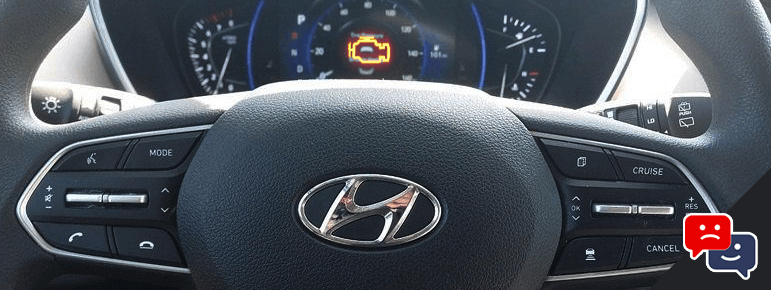Last Updated on April 19, 2024
Key Takeaways
- The Hyundai check engine light serves as an early warning system for potential car problems.
- A steady light could indicate minor issues like a loose gas cap or bad fuel, while a flashing light suggests a serious engine problem.
- Common causes include a loose gas cap, dirty or faulty mass airflow sensor, vacuum leaks, catalytic converter malfunction, failing spark plugs, or oil consumption.
Seeing the dreaded Hyundai check engine light might be the last thing you need on your way home from work. But this simple light can give you forewarning of a problem that’s better addressed now than later.
A steady check engine light can mean a loose or missing gas cap, faulty 02 sensor, damaged catalytic converter, faulty mass air-flow sensor, or even a cylinder misfire. A flashing Hyundai check engine light indicates a more serious engine problem, and service is required immediately.
Fact is, this warning light means there is an issue somewhere in your car’s mechanical or emissions control system.
Truthfully, it doesn’t matter if you drive a Nissan, Buick, GMC, Hyundai, Mazda, or Ford – eventually you see the check engine warning light up.
But don’t panic! In this quick guide, we’ll take a look into what could be causing your Check Engine light to come on, and how to troubleshoot potential solutions.
So buckle up and let’s get started on getting to the bottom of why this annoying little light won’t go away!
Why Is My Hyundai Check Engine Light On?
When the check engine light is illuminated on your dashboard, it could either be a minor fix like tightening or replacing your gas cap. However, it could be something much more serious – such as a bad catalytic converter.
Depending on the severity of the problem, this light will either be a steady illumination, or a blinking light.
If it’s a a steady glow, then this means something less serious is going on. Such as a loose gas cap, or a tank of bad fuel. Continuing to drive with a steady check engine light until you can get the vehicle into service is generally considered safe.
However, a flashing check engine light indicates that your car’s engine or transmission has a serious problem.
If you notice your check engine light is blinking, get the vehicle to a Hyundai service center immediately. It’s also not recommended you continue to drive the vehicle.
Here’s some possible reasons for that pesky check engine light.
Loose Gas Cap
Is your gas cap is loose or missing completely? This is one possibility that you can quickly check in a matter of seconds.
It’s easy to leave it off when filling up at the gas station. And doing so, then you can expect the check engine light to appear shortly after driving away.
Dirty or Bad Mass Airflow Sensor
The mass airflow sensor is responsible for determining the amount of air that enters the engine. It adjusts to changes in altitude and monitoring the air-fuel mixture.
Commonly associated problems include difficulty starting or a rough idle. Cleaning or replacing the part should fix the issue, and stop the Hyundai check engine light.
Vacuum Leak
Vacuum hoses are critical to your car’s engine. They help to maintain proper pressure within the engine. When vacuum hoses go bad, that entire process can fall apart due to pressure loss.
The precision of the air-fuel mixture is paramount to engine performance. So when there’s a vacuum leak, that ratio will be off. This causes issues like high RPM in idle, random power surges or misfires.
In response, the Hyundai check engine light will turn on. Finding the vacuum leak will solve the issue.
Catalytic Converter Malfunction
The catalytic converter filters the majority of harmful fumes produced by combustion and renders them inert.
A damaged, overheated, or missing converter can cause a car to trigger the check engine light. Moreover, back siphoning of fumes can cause poor engine performance.
Failing Spark Plugs
Spark plugs ignite the air-fuel mixture in the combustion chamber, and a failure to ignite or mistimed ignition causes problems in your engine.
Have your mechanic conduct an examination of the spark plugs and replace any that are malfunctioning.
Oil Consumption
If your Hyundai is consuming oil at a high rate – causing the oil levels to get dangerously low. When this happens, the check engine light will turn on.
How do I Turn Off Hyundai Check Engine Light?
If something simple, say a loose gas cap triggered your check engine light – resetting it is easy.
To do so, pop the hood of your car and locate the battery. Then, disconnect the ground wire on the car battery. This is black wire connected to the battery, and typically has a (-) symbol.
Once disconnected, wait a few minutes then reconnect. Then, restart the car and drive a few miles for the check engine light to disappear.
Will the Check Engine Light Reset Itself?
Yes, once the vehicles onboard computers determine the problem has been fixed. On average, driving 20 to 40 miles will give the cars ECU enough time to reset the check engine light.
What if I Reset my Hyundai Check Engine Light But it Comes Back on?
Did your Hyundai’s check engine light came back on after resetting it? So what do you do next? If your facing this delima, it’s best to call your local mechanic or Hyundai dealership.
The root cause for a reoccurring check engine light may be due to an electrical or sensor problem.
Final Thoughts
There are a number of causes that can make your check engine light come on, and when you do spot this bad omen on your instrument cluster, it’s always wise to take the car into the shop for repairs as soon as you’re able to.
The bottom line is, if you see your Hyundai check engine light come on, don’t ignore it. Depending on the problem, you may be able to move forward without much issue or you might need to get the car serviced right away.
If it’s just a bad gas cap, your local parts store can help you out. If it’s a flashing check engine light – get to a mechanic as soon as possible.
Taking care of this problem quickly can save money and ensure your Hyundai continues running safely and reliably for years to come.

Managing Editor
Christopher is an automotive technical writer. When he’s not at the local autocross event, he can often be found working on one of his cars. Specializes in automotive class action law, industry trends, and automotive maintenance. Email me direct, or learn more about us

